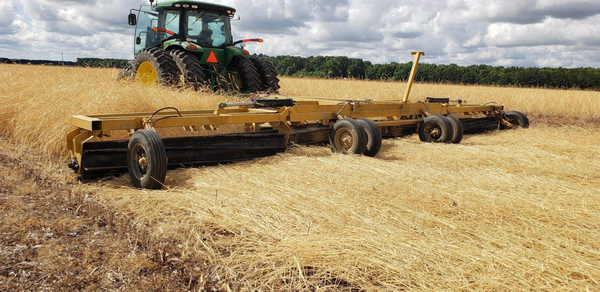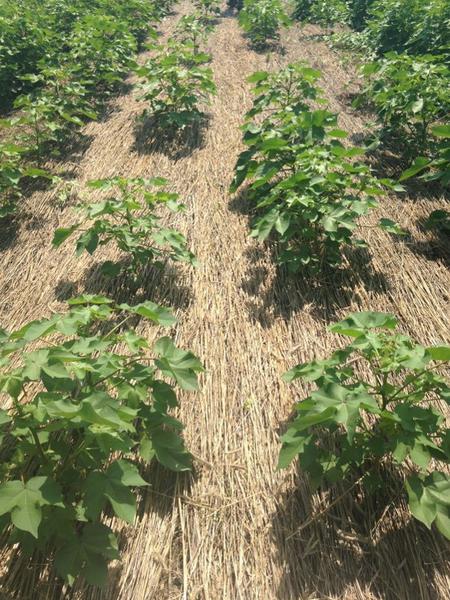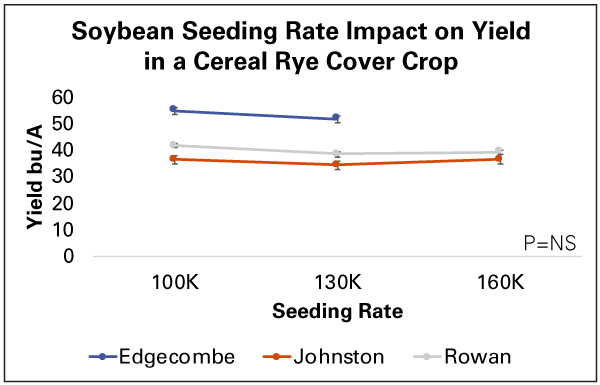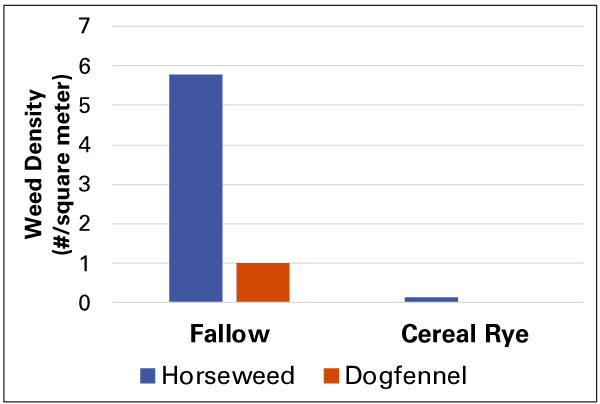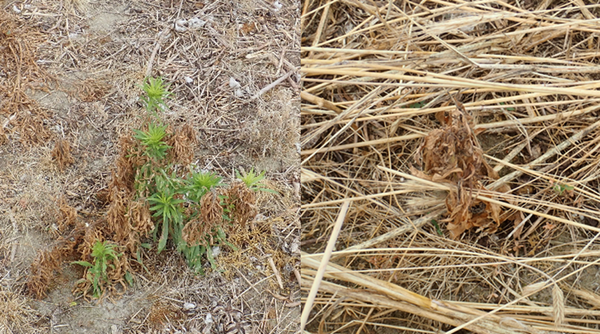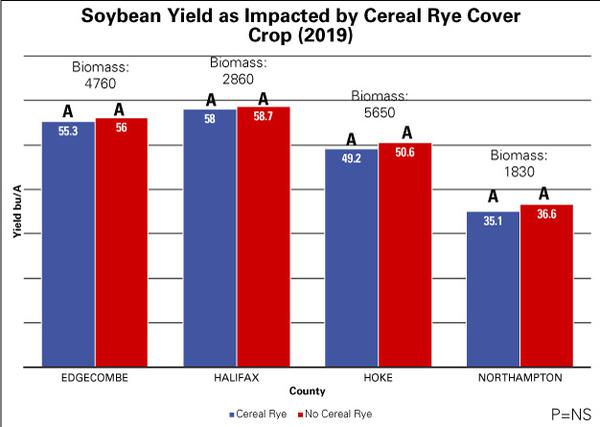Cover Crop Use in North Carolina
More than 450,000 acres of cover crops were planted in North Carolina in 2017.1 North Carolina famers use cover crops for a variety of reasons. Historically, the longer-term benefits of cover crops have been emphasized; however, in recent years, focus has shifted to the short-term benefits from cover crop use, including conserving soil moisture and suppressing weeds. North Carolina growers need to choose cover crop species and manage their cover crops to maximize the desired benefits.
1 USDA-NASS. 2017 Census of Agriculture.
Why Cereal Rye?
Most cover crop benefits are correlated with biomass production—the more biomass, the more benefits. Cereal rye is the highest biomass-producing winter cover crop that can be grown in North Carolina. Cereal rye also breaks down slower than many other species of cover crops due to a high carbon-to-nitrogen ratio. Cereal rye seed is readily available across the state and relatively inexpensive. It is also resilient and can grow well across a range of production systems.
Cereal Rye Management
Proper management of cereal rye is critical to optimize agronomic benefits. Dry biomass production can range anywhere from 1,500 to 12,000 lb/A. Several factors are associated with achieving higher cereal rye biomass levels:
- Early establishment: Planting cereal rye before November is ideal to help ensure optimum biomass production. Having cereal rye established by November can be a challenge due to the rotational complexity in many North Carolina crop rotations.
- Drilled versus aerial seeding: Cereal rye can be successfully established by either drilling or aerial seeding; however, the success of aerial seeding is highly variable and dependent on post-seeding moisture. Drilling is generally regarded as the superior seeding method for optimizing biomass production.
- Seeding rate: Seeding rates of 50 lb/A or higher will aid in optimizing biomass production.
- Termination timing: Delaying termination until cereal rye reaches flowering stage will help optimize biomass production.
Even when using optimal cereal rye management practices, weather can have a large influence on biomass production. In 2019, a series of on-farm trials were conducted across North Carolina to investigate the benefits of a cereal rye cover crop mulch in cotton and soybean production. On-farm cooperators were asked to drill cereal rye at a minimum of 90 lb/A by the end of October. Growers then applied 20 lb N/A at two to three weeks after cereal rye planting in an effort to optimize biomass. Growers terminated the cover crop via rolling and herbicide burndown after April 15. Despite managing cereal rye for optimal biomass production, cover crop biomass levels were 1,830 to 5,650 lb dry biomass/A (Table 1).
|
Site |
Cover Crop Planting Date |
Average Dry Cover Crop Biomass (lb/A) |
Cotton Planting Date |
Soybean Planting Date |
|
Edgecombe County |
Early October |
4760 |
5/7/2019 |
5/6/2019 |
|
Halifax County |
Mid September |
2860 |
5/9/2019 |
5/9/2019 |
|
Hoke County |
Late September |
5650 |
5/10/2019 |
4/27/2019 |
|
Northampton County |
Late October |
1830 |
5/20/2019 |
5/21/2019 |
Cover Crop Termination Considerations
Cereal rye can be terminated via herbicides, cultivation, or rolling. Each method has advantages and disadvantages. Using herbicides for cover crop termination can be very effective and facilitate planting into standing cereal rye when a roller is not available. Rolling cereal rye for termination has become increasingly popular for terminating cover crops. A roller-crimper (Figure 1) can be purchased, or growers can fabricate their own rollers (Figure 2). Rollers can be front- or back-mounted on a tractor, and there are even new roller units that can be added directly to a planter. If rolling cereal rye is the sole method of termination, soft dough stage should be targeted for termination. Rolling the cereal rye in the opposite direction in which it was drilled can aid in covering the soil surface and optimizing benefits. Cash crops should be planted in the same direction in which the cereal rye was rolled. Many producers will combine herbicide burndown and rolling as a method of termination.
Impact on Cotton and Soybean Stand
One of the largest challenges associated with using cereal rye as a cover crop is getting a good cash crop stand, especially when the cereal rye is rolled onto the soil surface. Growers using this system often have to spend several years modifying their planters to move the cereal rye residue in ways that facilitate optimum seed-to-soil contact. In previous cover crop research conducted in North Carolina, cotton stand was reduced when planting cotton into both a rolled and standing cereal rye cover crop mulch (Figure 3). Soybean stand can also be adversely impacted if good seed-to-soil contact is not achieved when planting the cash crop. Cotton and soybeans are two of the more flexible row crops for compensation of yield from stand loss. Because stand reduction when planting into a cover crop mulch can occur, this flexibility is a benefit of these two crops planted into a cereal rye cover crop mulch compared to a crop like corn that is very sensitive to stand loss. If the inability to penetrate through the residue becomes severe, yield losses will occur for cotton and soybeans. It becomes increasingly difficult to penetrate through the cover crop residue if the residue is not removed from the crop row or if the residue has any moisture. In 2019, soybean seeding rate was evaluated at three locations in which soybeans were planted into a standing cereal rye cover crop (Table 2). Cereal rye biomass levels ranged from 3,740 to 8,180 lb dry matter/A. Seeding rate had no impact on yield (PS=NS, Figure 4), indicating that currently recommended soybean seeding rates are adequate for planting soybeans into a cereal rye cover crop.
|
Site |
Cover Crop Planting Date |
Cover Crop Termination Date |
Cover Crop Dry Biomass (lb/A) |
Soybean Planting Date |
Soybean Variety |
|
Edgecombe County |
10/9/2018 |
4/25/2019 |
5070 |
5/6/2019 |
S64XT18 |
|
Johnston County |
10/16/2018 |
5/2/2019 |
3740 |
5/15/2019 |
S52RS86 |
|
Rowan County |
10/18/2018 |
5/10/2019 |
8180 |
5/10/2019 |
S52-Y7X |
Soil Moisture Retention Benefits
One of the primary benefits of the rolled cereal rye system is improved soil moisture retention. High biomass cover crops such as cereal rye provide a noticeably thick layer of organic matter cover on the soil surface, compared to some of the standard cover crop programs that have been used for several years, such as sown or drilled wheat. Immediately after cereal rye is terminated and rolled, a 2- to 3-inch layer of thick ground cover is established on the soil surface, assuming biomass development was sufficient. This layer of organic matter allows for improved rainfall penetration into the soil, with less runoff compared to bare-ground or minimal-ground cover systems. It also serves as a barrier that reduces direct sunlight from reaching the soil surface and reduces evaporation of moisture directly from the soil surface.
North Carolina frequently experiences episodic drought within a given growing season. This common occurrence, coupled with a low percentage of irrigated acreage, increases the likelihood of yield loss resulting from even short-term dry spells that occur during the summer months, especially on sandier soils. In some cases, a high biomass cover crop system could retain soil moisture for a longer period of time and extend received moisture to reduce the length and severity of short-lived dry spells. In our 2019 research, soil moisture was conserved variably across our sites (Table 3). In excessively dry years, this could minimize crop stress and yield loss resulting from episodic drought. Figure 5 illustrates the effect of the heavy rolled cereal rye residue on surface moisture retention compared to bare ground, where sunlight causes evaporative losses of surface moisture.
|
Treatment |
Sample Date |
Edgecombe County |
Halifax County |
Hoke County |
Northampton County |
|
|
|
Soil Moisture (%) |
|||
|
Cereal Rye |
Mid May |
21.4A |
23.5A |
9.6A |
- |
|
No Cereal Rye |
|
21.1A |
16.8B |
8A |
- |
|
Cereal Rye |
Late May |
12.8A |
14.0A |
7.7A |
- |
|
No Cereal Rye |
|
10.7B |
10.6B |
5.6B |
- |
|
Cereal Rye |
Mid June |
23.7A |
22.6A |
19.3A |
21.9A |
|
No Cereal Rye |
|
17.6B |
19.8B |
17.5B |
19.0B |
|
Cereal Rye |
Late June |
19.0A |
15.4A |
5.6A |
15.9A |
|
No Cereal Rye |
|
12.8B |
15.6A |
3.9B |
14.4A |
|
Cereal Rye |
Mid July |
6.5A |
27.5A |
23.2A |
28.8A |
|
No Cereal Rye |
|
5.7B |
28.6A |
23.9A |
28.8A |
|
Cereal Rye |
Late July |
4.7A |
17.7A |
2.8A |
6.0A |
|
No Cereal Rye |
|
4.5A |
17.3A |
2.4A |
5.5A |
|
Cereal Rye |
Early Aug |
22.9A |
20.3A |
6.5A |
6.6A |
|
No Cereal Rye |
|
22.4A |
18.1A |
6.1A |
6.5A |
|
Cereal Rye |
Mid August |
9.8A |
18.3A |
- |
5.5A |
|
No Cereal Rye |
|
8.8B |
17.8A |
- |
5.7A |
Higher soil moisture retention could also bring about some challenges. Cotton is known to be very sensitive to cool, wet weather during emergence and soon after. A cereal rye cover crop mulch could retain moisture at adversely high levels during the planting season, which could prolong cotton emergence or reduce stands if moisture is excessive and temperatures are cool. In hot, dry springs, however, this system could retain moisture to ideal levels for planting. Timing of cover crop termination, with special attention given to prevailing weather, could help improve the chances of success when implementing a cereal rye cover crop.
Prior to termination, the cover crop is often using more soil moisture compared to fallow ground. In springs where temperatures are warm and moisture is limited prior to planting of the summer crop, it may be problematic if cover crop termination occurs in close proximity to cash crop planting. In these scenarios, the cover crop should be terminated when maximum biomass is reached several weeks prior to planting. In wet springs, growers often find that cover crops that used soil water facilitated earlier cash crop planting.
Weed Suppression Benefits
In response to herbicide-resistant weeds, weed Extension specialists recommend integrated weed management that combines cultural, mechanical, chemical, and biological methods of weed control. Cover crops are an integral component of a multifaceted weed management program. Cover crops work to suppress weeds in several ways, including (1) physical interference of newly germinated weed seedlings; (2) moderation of weed seed germination cues (light, temperature, soil moisture, oxygen, nutrients); (3) allelopathy; and (4) competition with emerged weeds for essential resources.
To suppress small-seeded summer annual weeds species such as Palmer amaranth (pigweed), >5,000 lb dry biomass/A is generally recommended. This level of biomass production can be difficult to achieve in most situations. However, even if >5,000 lb dry biomass/A is not achieved, the benefits to weed management remain. For example, only 4,760 lb dry biomass/A were produced at the Edgecombe County location during 2019 (Table 1). Despite modest cover crop biomass at this location, cereal rye reduced Palmer amaranth and annual grass density approximately 90% compared to fallow treatments 50 days after planting (Figure 6). Previous research has determined that cover crops will not completely replace the need for herbicides. They can, however, alleviate selection pressure for herbicide-resistant weeds. At this location, Liberty (glufosinate) was applied postemergence just after weed densities were collected. Because the cereal rye cover crop reduced Palmer amaranth density by 90%, the chances of selecting for a Palmer amaranth biotype resistant to Liberty in the cereal rye treatment were less compared to the fallow treatment. Weed pressure at the other 2019 research sites was minimal.
In addition to summer annual weed suppression, the use of cover crops to manage winter annual weed species prior to cash crop planting has been undervalued. At the Northampton County site, cover crop biomass totaled just 1,830 lb/A. Although not adequate for suppression of summer annual weeds like Palmer amaranth, cereal rye at this location did have an effect on horseweed, another troublesome herbicide-resistant winter weed (Figure 7).
At this site, the cereal rye cover crop reduced horseweed density 98% compared to the fallow treatment (Figure 8). Similarly, fallow treatments averaged one dogfennel plant per square meter compared to none in plots planted with cereal rye. Furthermore, horseweed present in the cereal rye plots were smaller and more easily controlled by Gramoxone (paraquat) applied prior to cotton and soybean planting (Figure 9). Applying herbicides to large weeds has the similar effect of applying reduced rates to smaller weeds, which has serious resistance implications. Reduced rates or full rates applied to large weeds selects for tolerant individuals within the population; over several seasons, this practice can eventually lead to resistance.
Growers should consider integrating cover crops into their weed management programs. As demonstrated in this research, cover crops compete with winter annual species and can simplify cash crop land preparation. Cereal rye can suppress small-seeded summer annual weeds like Palmer amaranth. Most important, long-term adoption of cover crops will help delay the development of herbicide-resistant weeds.
Cereal Rye Impact on Cotton and Soybean Yield
Despite multiple documented short-term and long-term benefits from a cereal rye cover crop mulch in cotton and soybean fields, the effects on yield are variable. In the series of trials conducted during 2019, cotton and soybean yields were generally not affected by the presence of a cereal rye cover crop mulch regardless of achieved cover crop biomass (Figure 10a and Figure 10b). Soil moisture at these sites was likely adequate to prevent yield limitations. However, there are many scenarios in which the duration and severity of drought can negatively affect yields, and in some cases, yields can be improved by the use of a cereal rye cover crop. There was one site where cotton yield was actually reduced by the use of cereal rye cover crop, which was likely due to difficulties at planting in achieving adequate cotton seed-to-soil contact. At the same site, soybean yield was unaffected by lower stand, demonstrating the plasticity of this crop to various populations.
Conclusions
Multiple short-term benefits can be achieved by using a cereal rye cover crop mulch in cotton and soybeans; however, benefits such as weed suppression and soil moisture retention do not always lead to cash crop yield increases.
Acknowlegments
The authors would like to acknowledge the following entities for financial support for research highlighted in this publication: NC Soybean Producers Association, Wrangler, NC Cotton Producers Association, NC Foundation for Soil & Water Conservation, NC Association of Soil & Water Conservation Districts, and North Carolina Soil & Water Conservation Districts.
Publication date: April 16, 2020
Reviewed/Revised: April 22, 2025
AG-877
Recommendations for the use of agricultural chemicals are included in this publication as a convenience to the reader. The use of brand names and any mention or listing of commercial products or services in this publication does not imply endorsement by NC State University or N.C. A&T State University nor discrimination against similar products or services not mentioned. Individuals who use agricultural chemicals are responsible for ensuring that the intended use complies with current regulations and conforms to the product label. Be sure to obtain current information about usage regulations and examine a current product label before applying any chemical. For assistance, contact your local N.C. Cooperative Extension county center.
N.C. Cooperative Extension prohibits discrimination and harassment regardless of age, color, disability, family and marital status, gender identity, national origin, political beliefs, race, religion, sex (including pregnancy), sexual orientation and veteran status.


